Question: I do have some interest in what scriptures may say to explain I guess the universe. I have an interest in those topics around how the universe was created and what is beyond our observable universe and I guess l would like to further understand if there may be some answers provided in Vedic scripture to answer the unanswerable questions of space. Hope that doesn’t sound too weird. I’ve always had a great interest in, and wonder for space and what else lies beyond.
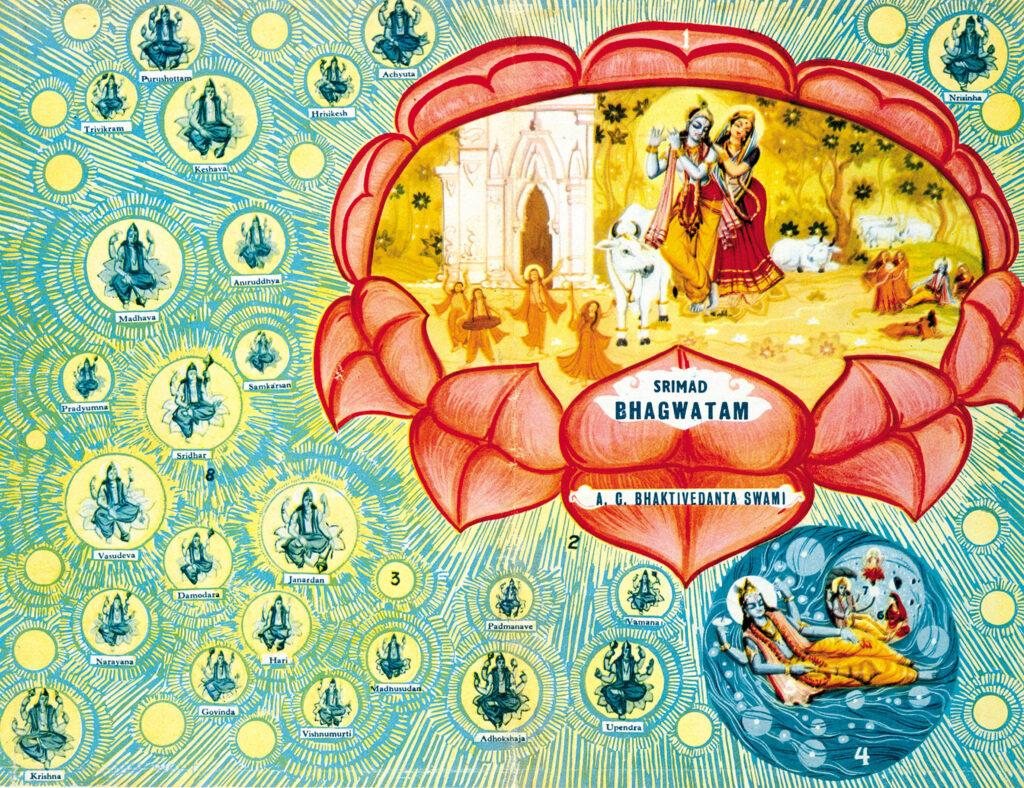
Cover of the original Srimad Bhagavatam Srila Bhaktivedanta Swami had published in Delhi prior to coming to the western world.
Answer:
There are vast amounts of detailed information on these subject matters in Srimad Bhagavatam and other Vedic literatures. Srimad Bhagavatam, which translates as “the beautiful narration of the Supreme Personality of Godhead” [Bhagavan], was written down 5000 years ago by the great sage Vyasadeva, who is known as the literary incarnation of the Supreme Lord. He describes Srimad Bhagavatam as being “the ripened fruit of the tree of Vedic knowledge.” Perhaps at a later date you can read Srimad Bhagavatam, when you have more time. It has been translated by Srila Bhaktivedanta Swami into 30 large books, which contain knowledge about the creation and structure of the universe, the spiritual world, the various incarnations of the Supreme Lord – Krishna and His various expansions – stories of great devotees and their teachings, and the process of devotional service – how to attain love for Krishna and return to the spiritual world from whence we came.
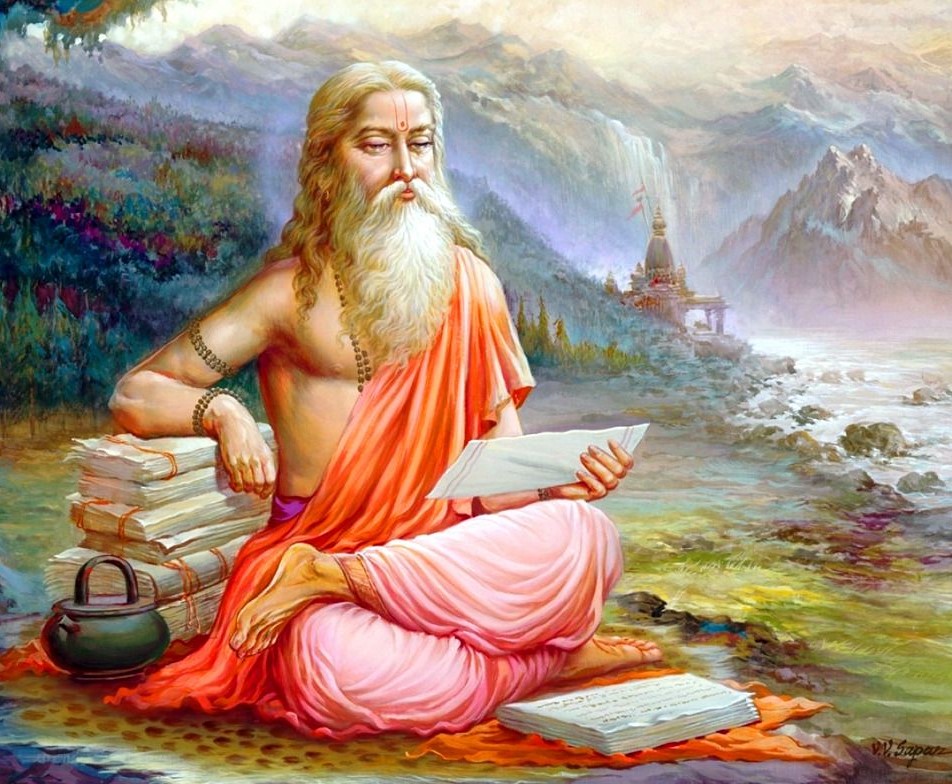
I must warn you that the knowledge about the creation and structure of the universe and the nature of the spiritual world is pretty far-out. Krishna is a far-out guy and He does far-out things. Some people, when they hear this knowledge, think it must be mythology because it does not fit in with their mundane speculative idea of things, or their limited experiences within this tiny speck of dust in a vast universe that we call planet earth. When He comes to this world, Krishna doesn’t wear a suit and tie and work in a bank. Everything He does is amazing because He is the most amazing, far-out and all-powerful personality. He has no limitations and anyone who thinks He could not do this or that or arrange things in a most amazing way is actually an atheist, because they do not accept Krishna’s unrivalled and unlimited supremacy. Krishna has inconceivable potencies.
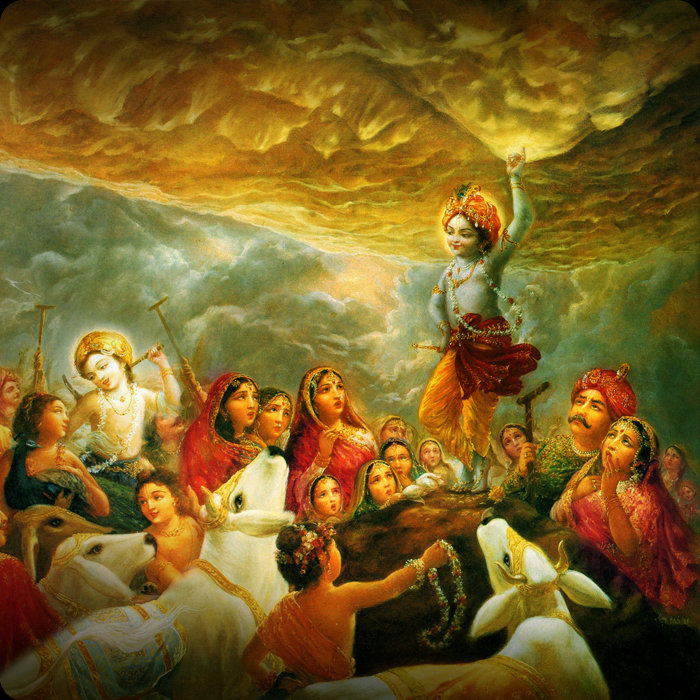
This is, of course, only a very brief and very simplified explanation for the creation and structure of the cosmos. Krishna’s creation – the spiritual and material worlds – are so vast and unlimited that even great sages and demigods who spend all eternity trying to understand Krishna, can only get a tiny glimpse into His majesty. Krishna is unlimited, as are his qualities, activities, creations and expansions.
Goloka Vrindavan
So, let us begin. If you look at the pictures of the cover of Srimad Bhagavatam canto 1, you will see a picture of Goloka Vrindavan, also known as Krishna loka, the eternal abode of Lord Krishna and His eternal loving associates. [Goloka – go means cows and loka means planet]. It is the home of the eternal cowherd boy, Gopal Krishna. He is accompanied by His eternal loving consort Radharani [Radhika] and His loving expansion and brother, Lord Balarama. [Radharani is also an expansion of Krishna, representing His internal or pleasure potency. When we chant the maha-mantra, Hare refers to Radharani and Rama refers to Lord Balarama.] Goloka Vrindavana is the highest and most wonderful destination. It also contains Lord Chaitanya and His associates, and when we go there, we can take part in both Krishna’s and Lord Chaitanya’s pastimes simultaneously. This planet resembles the whorl of a giant lotus flower. It is the original spiritual planet.
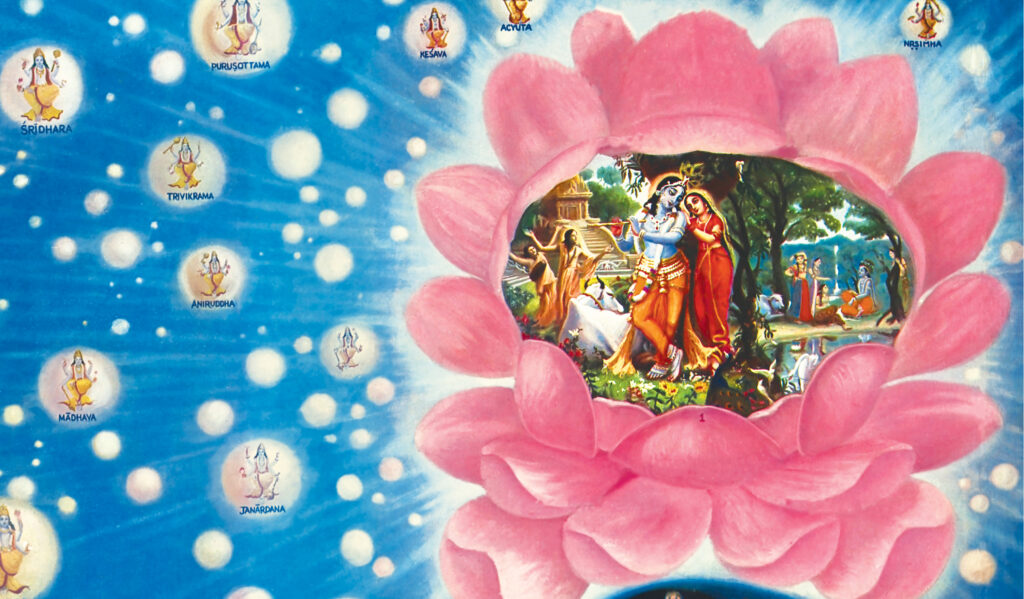
The Brahmajyoti
Krishna has the most dazzling spiritual effulgence, and this effulgence is known as the brahmajyoti or ocean of souls. This effulgence illuminates the entire spiritual world. It is also called the impersonal Brahman:
And I am the basis of the impersonal Brahman, which is the constitutional position of ultimate happiness, and which is immortal, imperishable and eternal.
[Krishna: Bhagavad-gita 14:27]
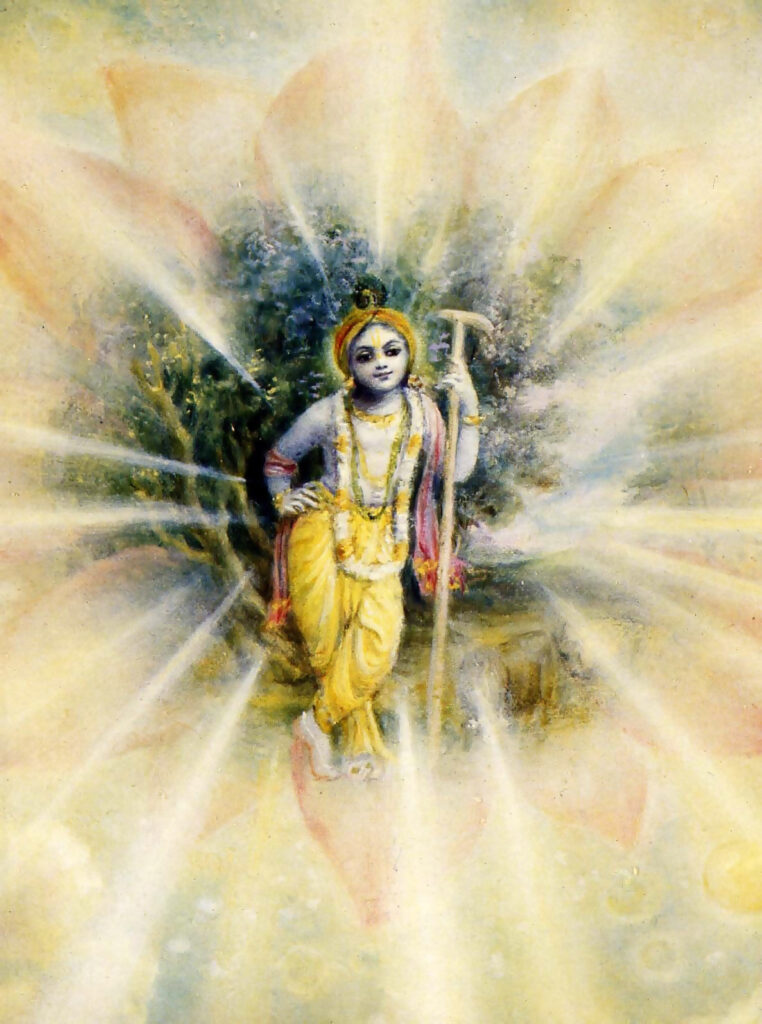
The Brahman effulgence is unlimited, and it is the destination of the impersonalist yogis who aim for liberation from the suffering of the material world, but are still tinged with envy and lacking in love for Krishna or the desire to serve Him. The Brahmajyoti is sometimes described as being the outer circumference of the spiritual world, as one who attains that realm has no awareness of Krishna or their own personal identity and form. In a merged condition, they experience only oneness – they have no awareness of others and are thus unable to experience love or engage in the loving spiritual pastimes that take place in the spiritual world. And because it is the nature of the soul to love and be active, this is only a temporary form of liberation. Eventually these souls will fall again into the material worlds, being dragged down by their desire to love and experience activity and variegatedness:
O lotus-eyed one, those who think they are liberated in this life but who are devoid of devotional service to You are of impure intelligence. Although they accept severe austerities and penances and rise to the spiritual position, to impersonal Brahman liberation, they fall down again because they neglect to worship Your lotus feet.
[Srimad Bhagavatam 10:2:32 and Caitanya-caritamra Madhya 25:32]
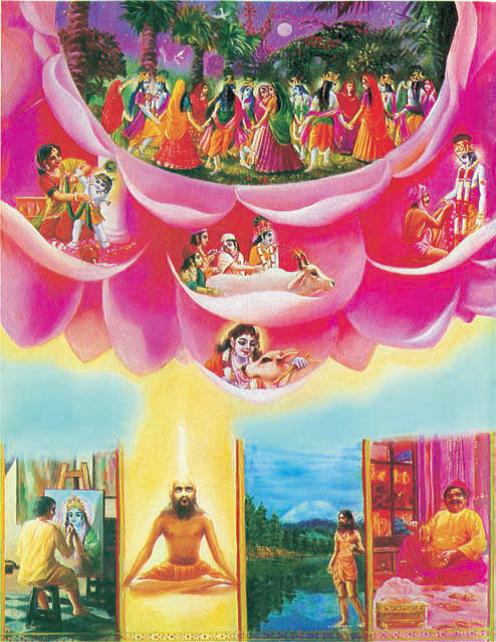
The yogi in this picture, second from left is practising mystic or astanga/kundalini yoga with the aim of merging into Krishna’s effulgence. To his right is a mystic yogi whose goal is develop mystic powers. The gentleman on the right is endeavouring for material enjoyment. On the extreme left, the bhakti yogi is serving Krishna as an artist.
The Vaikuntha Planets
Within the unlimited rays of the brahmajyoti, apart from Krishna’s abode, there are also unlimited spiritual planets where souls who have developed a loving relationship with one of Krishna’s unlimited expansions, such as Lord Vishnu, Lord Rama, Lord Nrsinghadeva etc. reside. As is shown on the cover of Srimad Bhagavatam, there are an unlimited number of Vaikuntha planets where Lord Vishnu – Krishna’s four-armed expansion – resides and is worshiped by innumerable souls. Vaikuntha means that place where there is no anxiety.
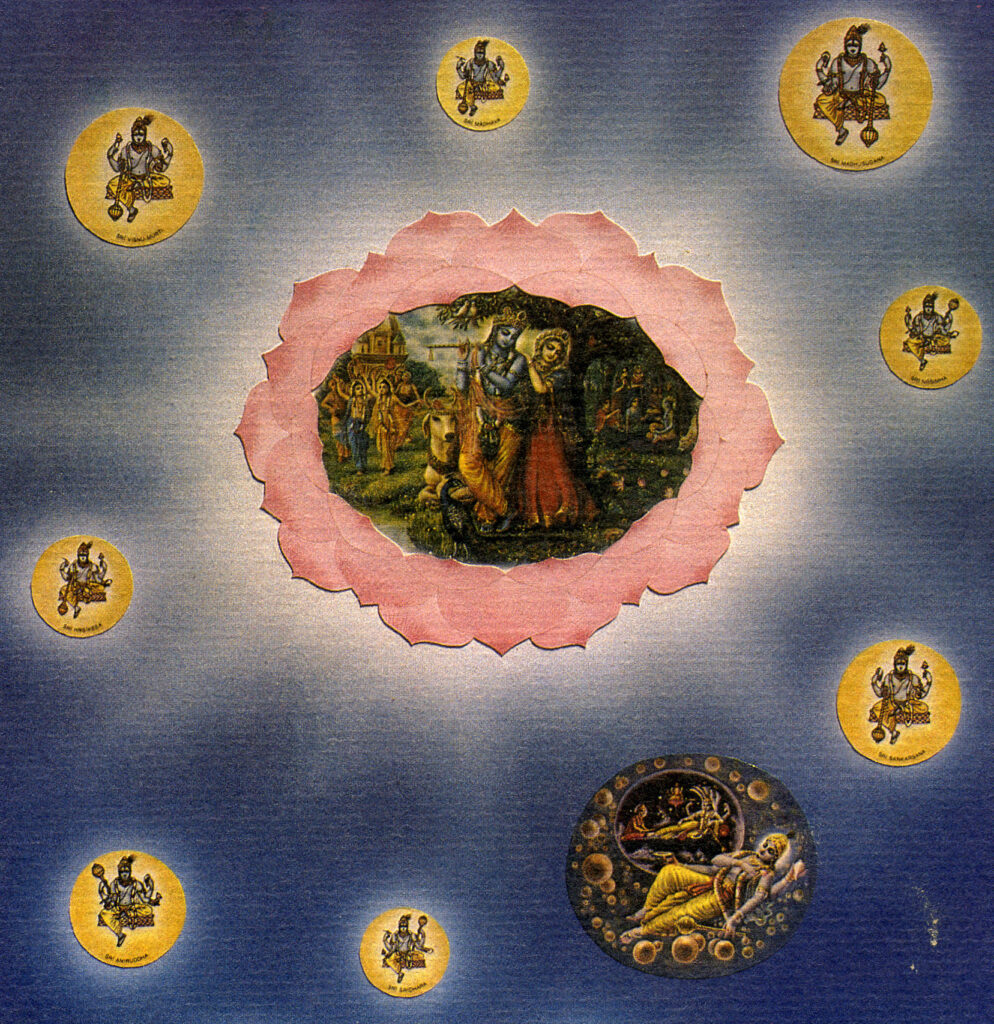
The souls in the Vaikuntha planets are fully satisfied and experiencing great ecstasy in their love for Lord Vishnu and His consort Lakshmi devi. These souls are eternally liberated. However, the happiness of the souls on these planets does not equal the happiness of the lovers of Krishna because their love is tinged with awe and reverence. The souls on the Vaikuntha planets are always aware that Lord Vishnu, or Narayana, is the Supreme Lord, so their worship is a bit more formal, a bit like a loving subject towards a benevolent king, although this analogy is very limited as the residents of Vaikuntha are enlightened souls who are experiencing love and happiness far beyond anything to be found in material relationships. Not that they are afraid of Lord Vishnu, but the relationships with Him are not on the same intimate level as the relationships the souls in Goloka Vrindavan experience with Krishna.
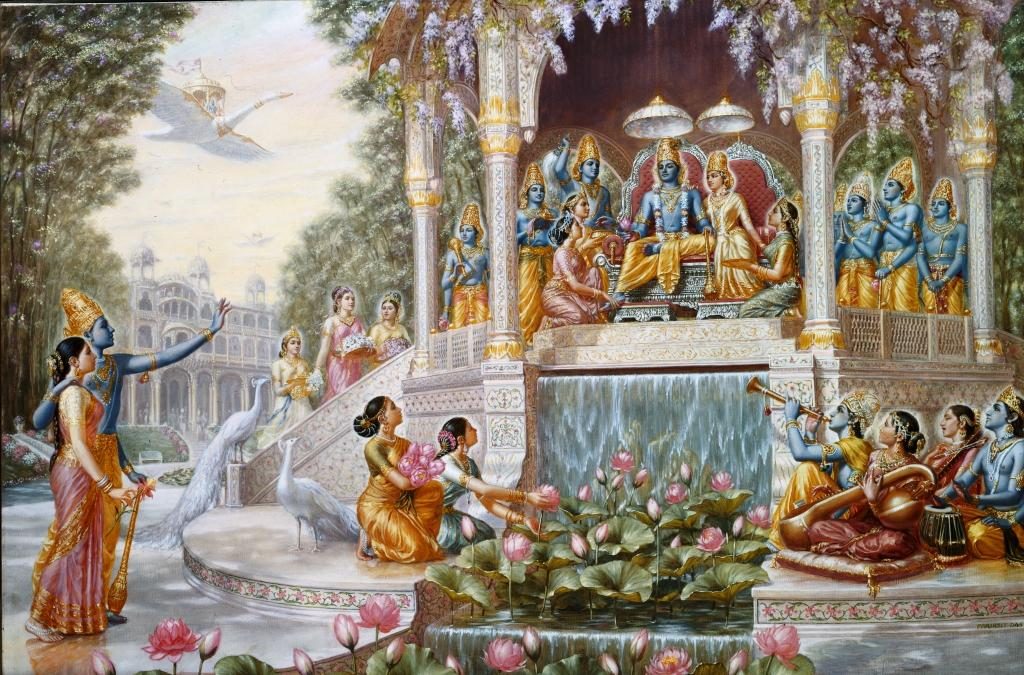
In Goloka Vrindavan, in order to experience the most intimate loving relationships with His devotees, Krishna makes them unaware that He is God. Instead, the residents of Goloka think of Krishna only as their dear-most friend, their sweetest child or their most gorgeous lover. By the power of yogamaya – the illusion of great love – they have no awe and reverence towards Krishna, and so when the other cowherd boys play with Krishna, they climb on His shoulders and challenge Him to playfights and races, make jokes with Him, pop sweet-balls into His mouth and treat Him as their dear friend and equal. And this is how Krishna wants to relate to His dear devotees – it is very intimate, friendly and informal. And everyone in Goloka thinks that they are the most-dear to Krishna, and indeed they are.
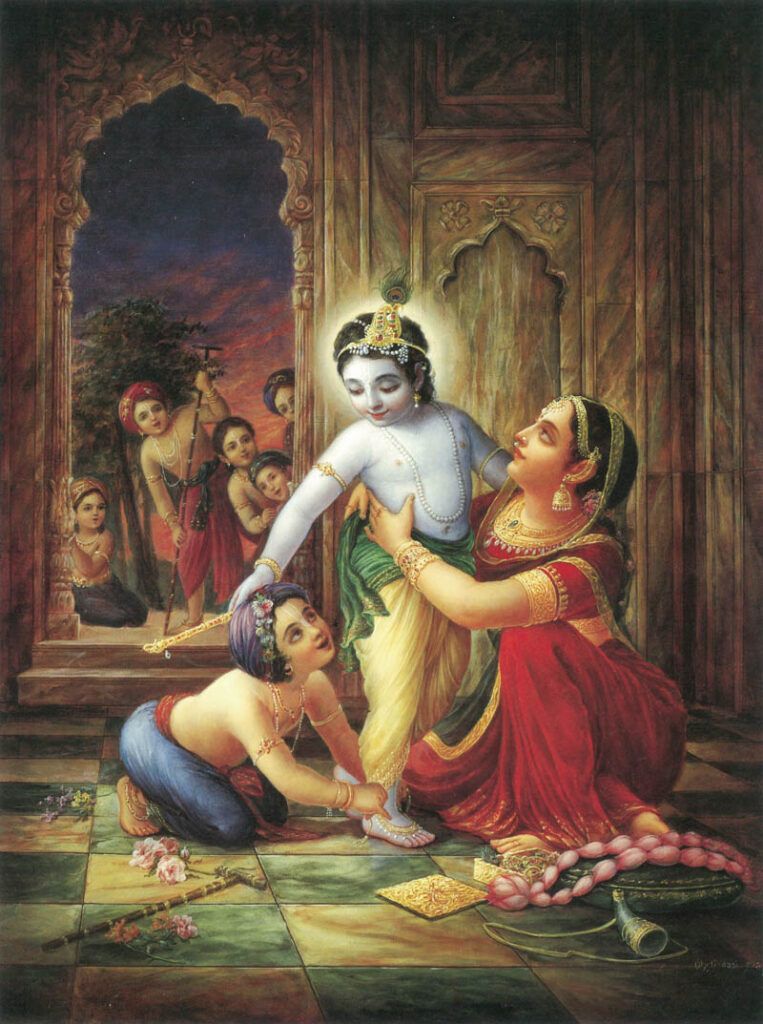
Maha-Vishnu
On the cover flap of the First canto of Srimad Bhagavatam it is said:
Sometimes a spiritual cloud overtakes a corner of the spiritual sky of Brahmajyoti, and the covered portion is called the Mahat-tattva [the sum total of the material creation]. The Lord then, by His portion as Maha-Vishnu, lies down in the water of the Mahat-tattva. The water is called the Causal Ocean [karana-jala]. As He sleeps within the Causal Ocean, innumerable universes are scattered all over the Causal Ocean. They stay during a breath of Maha-Vishnu.
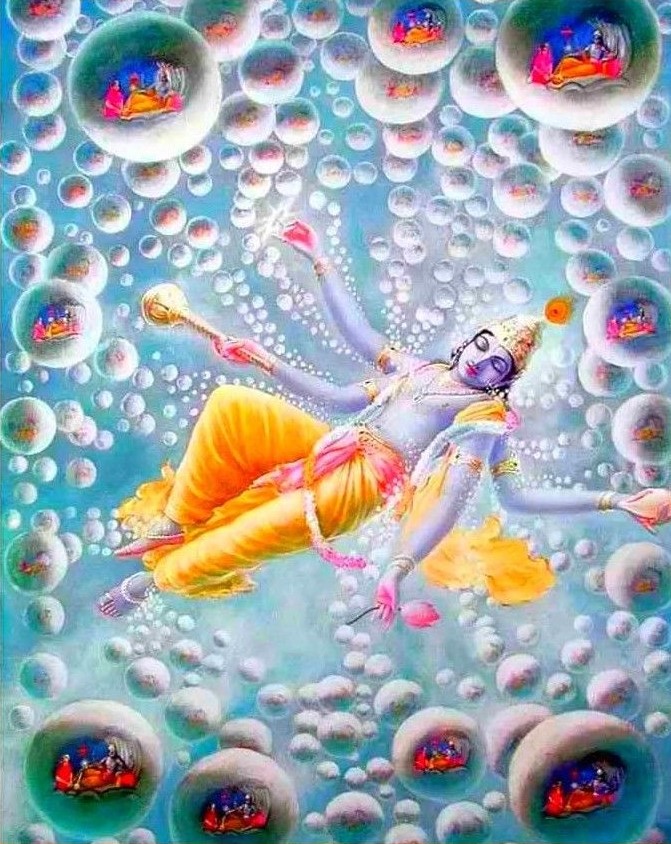
Krishna is the Supreme Enjoyer Who revels in pastimes of love. He is too busy enjoying loving pastimes with His devotees in the spiritual world to be directly engaged with the creation of the material worlds, but instead he acts through His Vishnu expansions and empowers living entities to act as creators [Brahmas] within each universe.
So, in order to create the innumerable material universes, Krishna expands Himself into a gigantic Vishnu form known as Maha-Vishnu [maha means great] and great He is. So great that innumerable universe come out from His breathing, just like germs or micro-organisms are spread from our breathing [hopefully not Corona Virus]. These material universes are manifest for the duration of Maha-Vishnu’s outgoing breath [trillions of years], and when He breaths in they return to within His body.
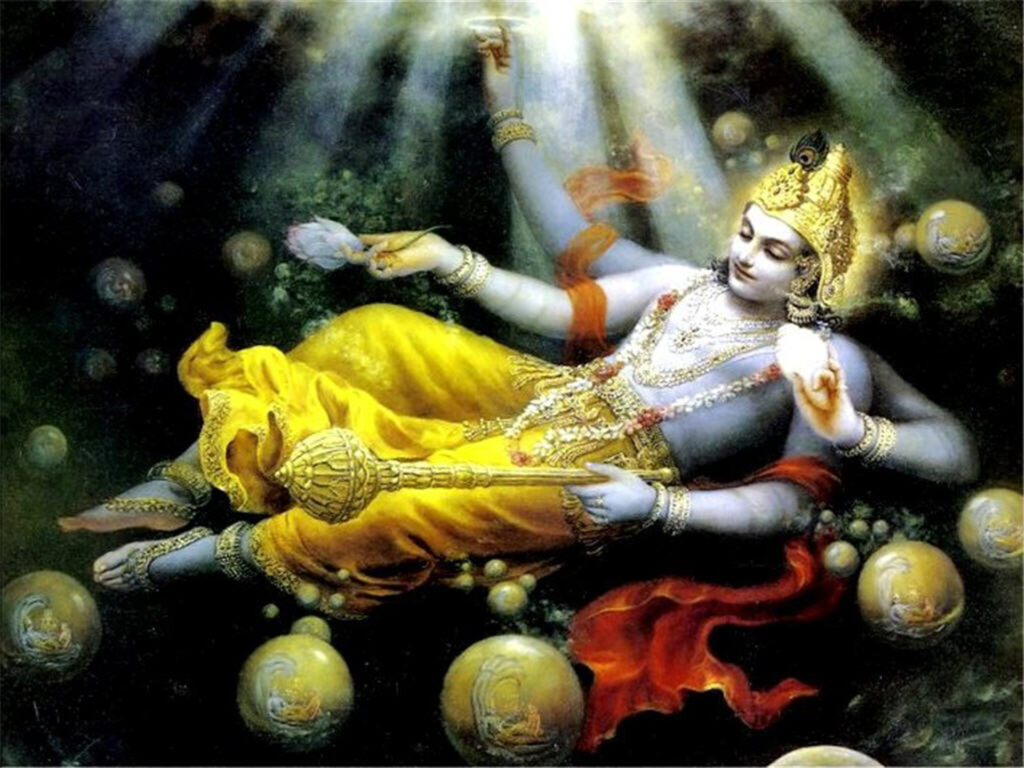
Garbhadaksayi Vishnu
The material universes are globes and are likened to a coconut. The outer shell of each universe is made of layers of the material elements – earth, water, fire, air ether, mind, intelligence and false ego. And these shells are so thick that it is impossible to pass through them except for the mercy of the Supreme Lord. In each of these material universes, Maha-Vishnu expands Himself into a form known as Garbhadaksayi Vishnu who lies in the Garbha Ocean on a serpent-like couch with many heads. This most beautiful serpent is known as Ananta Sesha. Just as Vishnu is an expansion of Krishna, Lord Ananta Sesha is an expansion of Lord Balarama. Wherever Krishna goes – for Lord Vishnu is also Krishna playing a different role – Lord Balarama also goes. When Lord Krishna appears as Lord Chaitanya, Lord Balarama appears as Lord Nityananda – they are eternally inseparable.
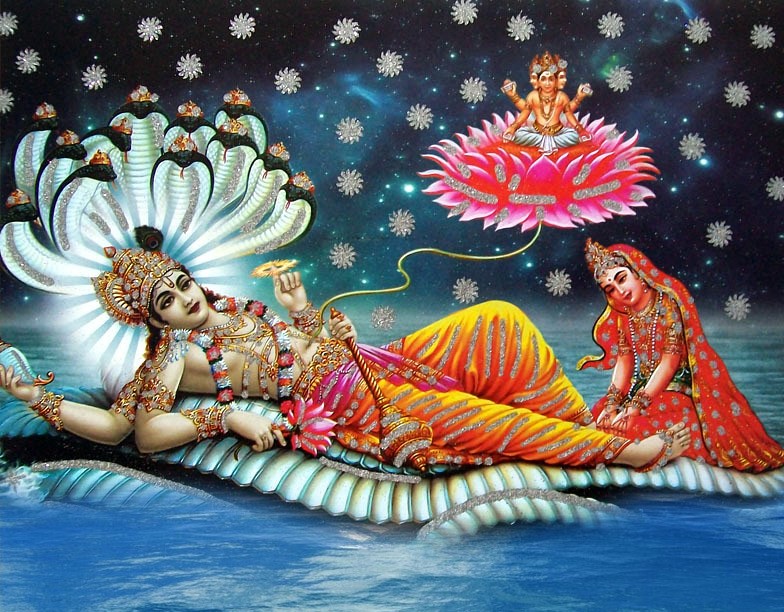
Lord Brahma
Within each universe, from the navel of Garbadaksayi Vishnu a lotus stem sprouts and grows through the universe. On this lotus seat, the creator and lord of that universe, Lord Brahma, is born. We are presently trapped in just one of innumerable material universes. Each one has a Lord Brahma, who is playing the role of creator of the planets within that universe and the bodies of all the various creatures. How big that universe is, is determined by how many heads that particular Brahma has. Our Lord Brahma has 4 heads as you may know. Lord Brahma explains in the Second Canto of Srimad Bhagavatam:
I create after the Lord’s creation by His personal effulgence (known as the brahmajyoti), just as when the sun manifests its fire, the moon, the firmament, the influential planets and the twinkling stars also manifest their brightness. … Inspired by Him only, I discover what is already created by Him (Narayana) under His vision as the all-pervading Supersoul, and I also am created by Him only.
[Srimad Bhagavatam 2:5:11,17] (Lord Brahma to Narada)
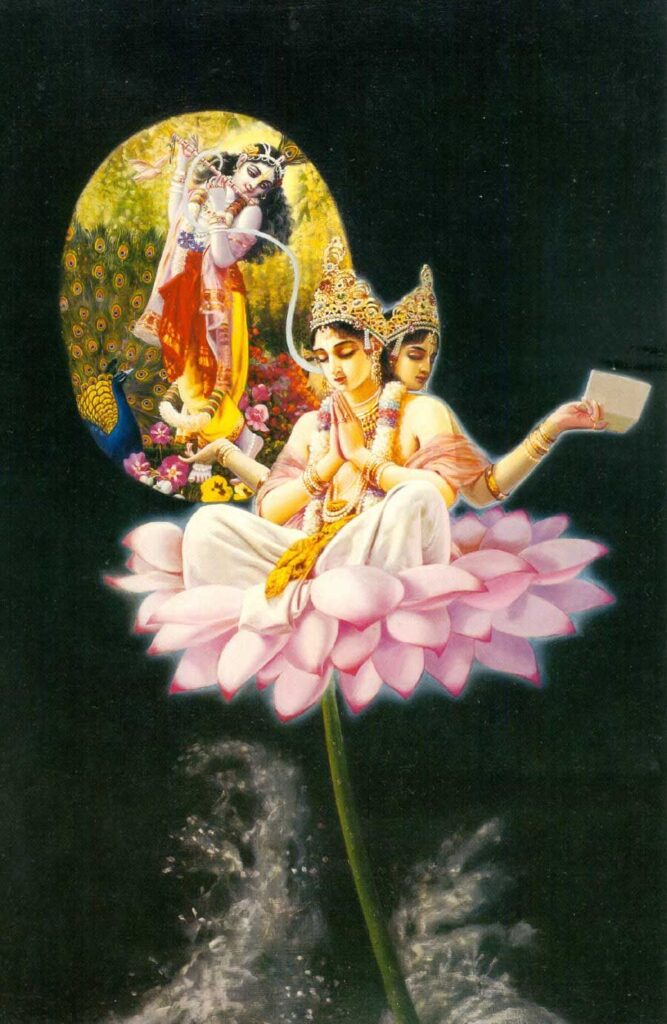
Apart from being creator, there is another function our Lord Brahma has – he distributes Vedic knowledge throughout the universe. It’s like if someone makes a product, say a washing machine, then they also put out a manual which tells us how to use it. So, the Vedas are the manual for how to live in the universe and then return to the spiritual world. Lord Brahma is the first spiritual master in our line of disciplic succession, after receiving Vedic knowledge directly from Krishna at the beginning of this creation. Srimad Bhagavatam describes Lord Brahma as the “form of manifest Vedic knowledge.”
He is devoted to the Supreme Personality of Godhead without deviation, and therefore in one sense he is not different from the Lord. Nevertheless, he should be worshiped not as the monists worship him, but in duality. One should always remain a servitor of the Supreme Lord, the Supreme worshipable Deity. We therefore offer our respectful obeisances unto Lord Brahma, the form of manifest Vedic knowledge.
[Srimad Bhagavatam 5:20:35]
Brahma is the personal representation of the Supreme Personality of Godhead as the source of transcendental sound and is therefore above the conception of manifested and unmanifested. Brahma is the complete form of the Absolute Truth and is invested with multifarious energies.
[Srimad Bhagavatam 3:12:48]
Lord Brahma’s foremost disciple is Narada Muni.
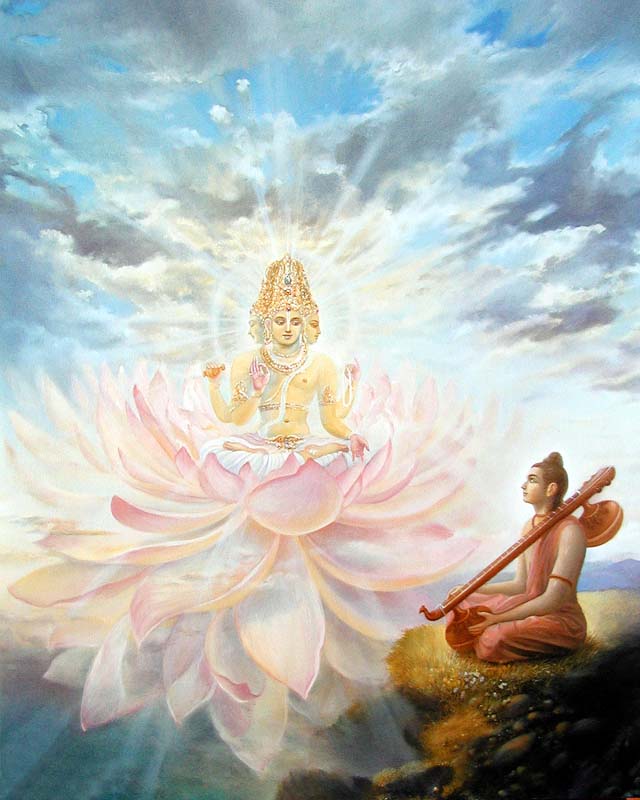
Beyond these material universes, which are sometimes manifested and sometimes not manifested, is the eternally unchanging spiritual world where Lord Krishna lives. Our Brahma lives for the entire duration of the cosmic manifestation of his universe, then returns to the spiritual world of Krishna. In other words, being Brahma is only a temporary role he fulfills, not his eternal spiritual identity. Our Brahma lives for 311 trillion years, of which he is about half way through. At the beginning of creation, he spoke some amazingly beautiful prayers glorifying Lord Govinda [Krishna] called the Brahma Samhita:
I worship Govinda, the primeval Lord, Who is endowed with great power. The glowing effulgence of His transcendental form is the impersonal Brahman, which is absolute, complete and unlimited, and which displays the varieties of countless planets, with their different opulences, in millions and millions of universes.
[Brahma Samhita 5:40]
I worship Govinda, the primeval Lord, Who is the original personality of Godhead. By His partial plenary expansion (Maha Vishnu), He enters into material nature, and then into each and every universe (as Garbodakasayi Vishnu), and then (as Ksirodakasayi Vishnu) into all the elements, including every atom of matter. Such manifestations of cosmic creation are innumerable, both in the universes and in the individual atoms.
[Brahma Samhita 5:35]

I worship the primeval Lord, Govinda, Who is always seen by the devotee whose eyes are anointed with the pulp of love. He is seen in His eternal form of Shyamasundar, situated within the heart of the devotee.
[Brahma Samhita 5:38]
I worship Govinda, the Primeval Lord, Who is adept in playing on His flute, with blooming eyes like lotus petals, with head bedecked with peacock’s feather, with the figure of beauty tinged with the hue of blue clouds, and His unique loveliness charming millions of cupids.
[Brahma Samhita 5:30]
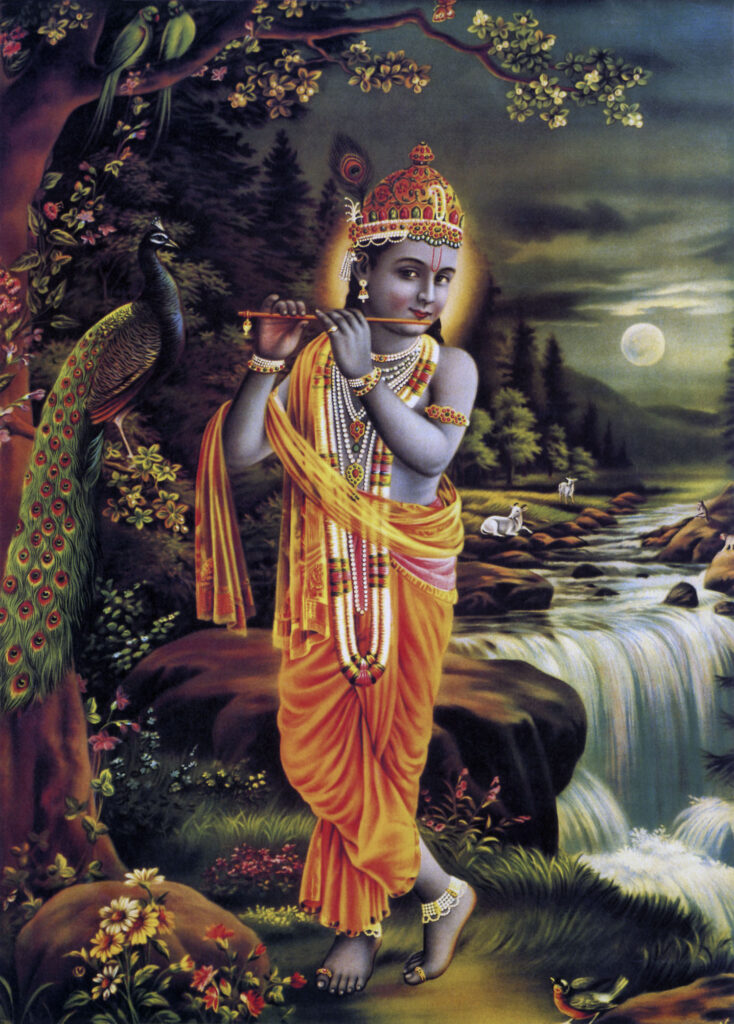
I worship Govinda, the Primeval Lord, round Whose neck is swinging a garland of flowers, beautified by the moon locket; Whose two hands are adorned with the flute and jewelled ornaments, Who always revels in pastimes of love. His graceful three-fold-bending form of Shyamasundar is eternally manifest.
[Brahma Samhita 5:31]
I worship Govinda the Primeval Lord, Whose transcendental form is full of bliss, truth and substantiality and is thus full of the most dazzling splendour. Each of the limbs of that transcendental figure possess in Himself the full-fledged functions of all the organs and eternally sees, maintains and manifests the infinite universes, both spiritual and mundane.
[Brahma Samhita 5:32]
I worship Govinda, the Primeval Lord, Who is the original person – absolute, infallible, without beginning, although expanded into unlimited forms, still the same original, the oldest, and the person always appearing as a fresh youth. Such eternal, blissful, all-knowing forms of the Lord are usually understood by the best Vedic scholars, but they are always manifest to pure unalloyed devotees.
[Brahma Samhita 5:33]
Ksiradaksayi Vishnu
Lord Garbhadaksayi Vishnu further expands Himself into Ksiradaksayi Vishnu Who is the collective Supersoul or Lord Paramatma – the Lord in the heart. As the Supersoul, He is expanded to accompany every living entity in every body throughout their sojourn through the material universe. Lord Paramatma pervades the material universe, and is within every atom of creation as well as in the hearts of all living entities. In all of our births from a germ to a whale to a human Krishna never leaves us. He is the witness to our activities and desires, and He fulfills our desires as our karma permits. In the Sri Isopanisad [mantra 8] He is described as:
… the self-sufficient Philosopher Who is awarding everyone’s desire since time immemorial.
The Supreme Lord is situated in everyone’s heart, O Arjuna, and is directing the wanderings of all living entities, who are seated as on a machine, made of the material energy.
[Bhagavad-gita 18:61]
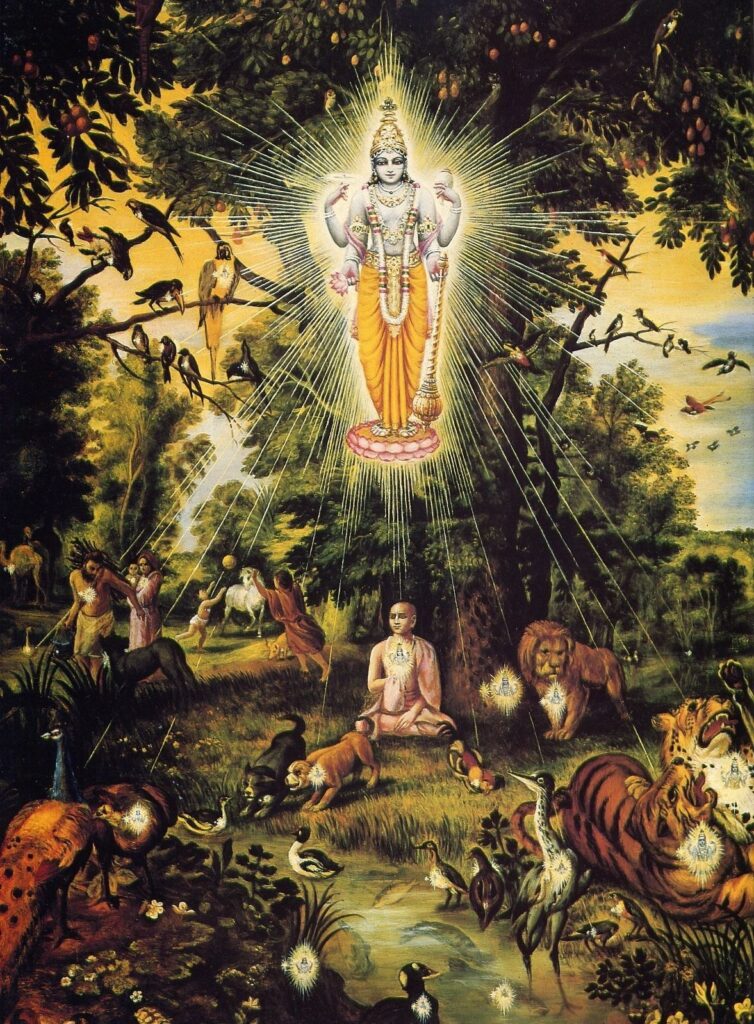
The Heavenly Planets
The structure of the material universe can be understood in a simplified fashion as having three planetary systems, sometimes referred to as the “three worlds.”
The upper or heavenly planets are where the demigods and many great sages reside. When we use the term heavenly, we are not referring to the spiritual world, or “heaven” as the term is used by Christians. The heavenly planets are places of superior enjoyment within the material world. They are not to be confused with the spiritual world, as they are not eternal, and one day they will cease to exist like everything within the material universes. The heavenly planets are places where many souls go to experience good karma. There is a long duration of life there and virtually no material suffering, but when the good karma has been used up, these souls fall down again to an earthly planet or perhaps lower.
The demigods are servants of the Supreme Lord in charge of various aspects of universal affairs. As an example, we may have a King who has ultimate control of his kingdom but he is not directly involved in the day-to-day running of the kingdom. Instead, he appoints ministers to be in charge of certain portfolios like roads and hospitals etc. In the same way, the Supreme Lord enjoys pastimes of love with His devotees in the spiritual world while empowering great demigods to manage universal affairs in the material universes.
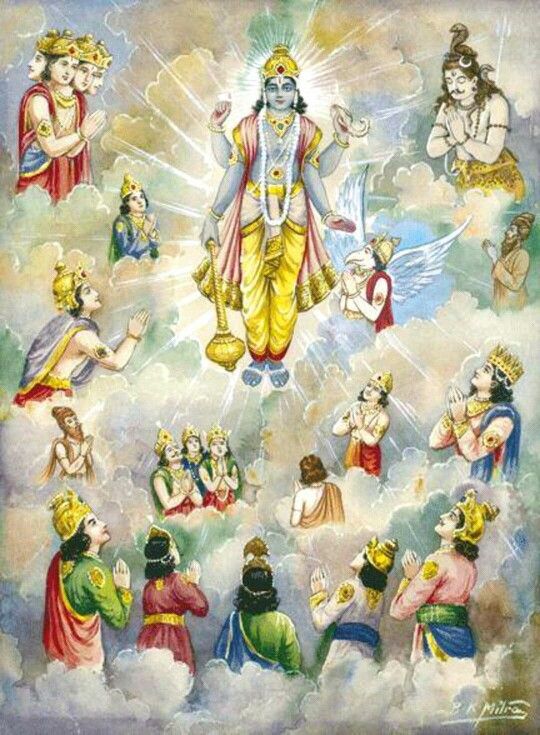
The demigods are all servants of the Supreme Lord. Many are great devotees of the Lord. Lord Brahma and his son Narada Muni are great spiritual masters in our line of disciplic succession, and we respect Lord Shiva is one of the greatest devotees of Lord Krishna – he is always in trance, meditating on Lord Krishna. So, it is not wrong to respect and worship demigods, but only as devotees of the Lord, not as the Supreme Lord. As soon as we put any devotee or demigod on an equal level with the Lord, or call Him Supreme, we commit an offence.
Men of small intelligence worship the demigods, and their fruits are limited and temporary. Those who worship the demigods go to the planets of the demigods, but My devotees ultimately reach My supreme planet.
[Bhagavad-gita 7:23]
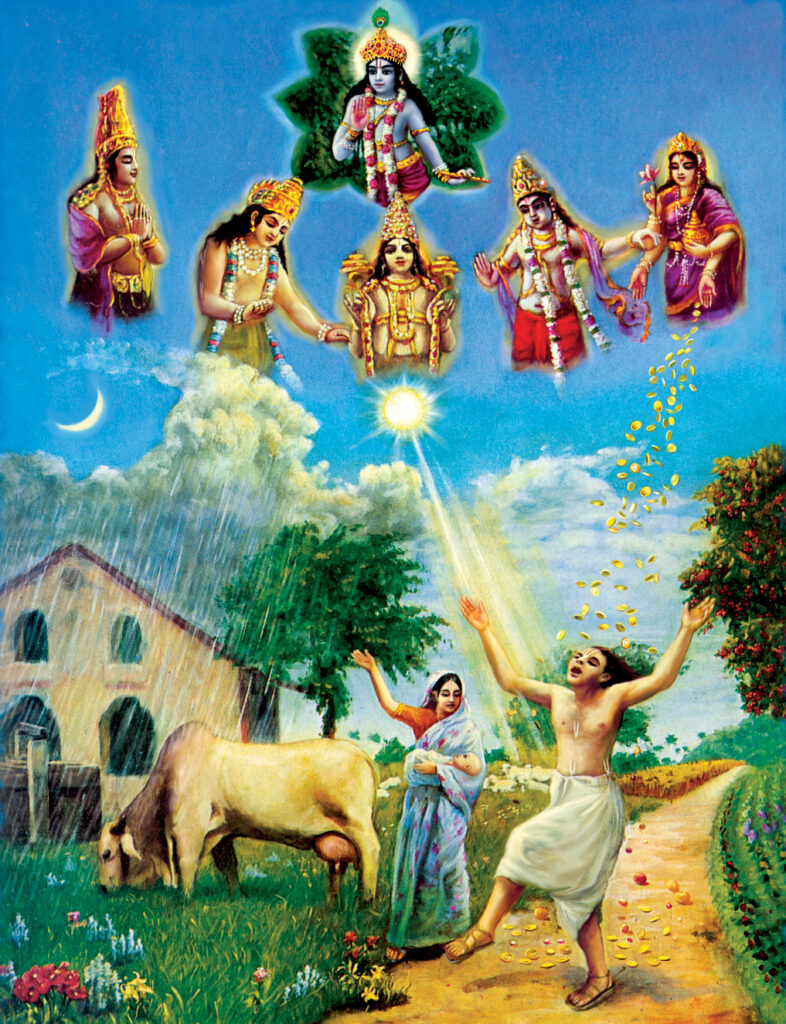
The Middle Planets
The middle or earthly planets, such as ours, have a mixture of material suffering and enjoyment. For instance, from our planet we can create good karma to be experienced here or in the heavenly planets, or we can create bad karma to be experienced here or in the hellish planets. Actually, our planet is very special within our universe, as when Lord Krishna comes to this universe, He resides in Vrindavan on earth. And Lord Chaitanya also takes birth in Navadvipa on our planet. These holy abodes of the Lord are said to be satellites of the original spiritual abode of the Lord. The wonderful thing about our planet is that we can be part of Lord Chaitanya’s sankirtan chanting movement and easily return back home to be with Krishna again. For this reason it is said that the demigods in the higher planetary systems are lining up to take birth on planet earth.
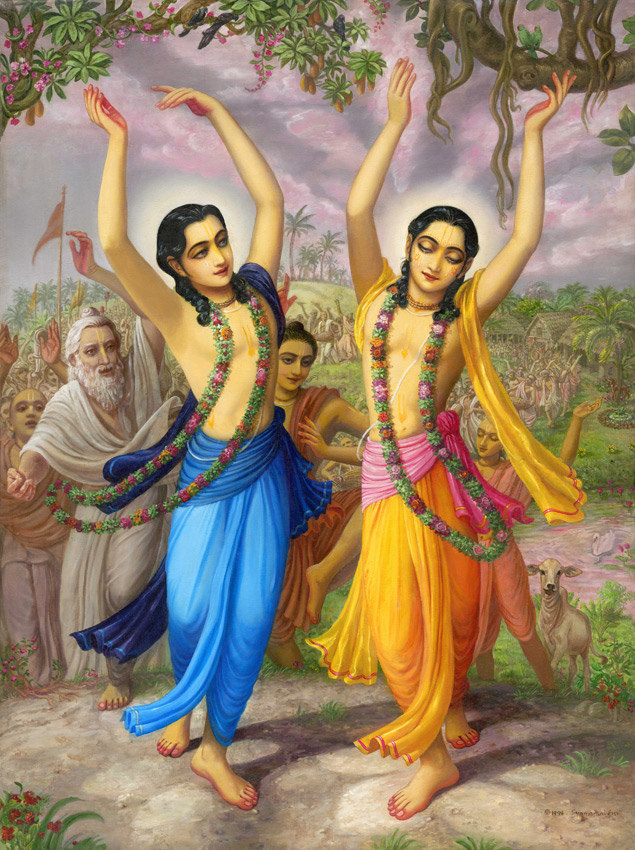
The Hellish Planets
The lower or hellish planets are places where people go to work off their bad karma. They are not places of eternal suffering, and people can also experience hellish suffering in a middle planet like ours without having to go to the hellish planets. Other types of hellish planets exist where there is a fair degree of material enjoyment, but there is no understanding or awareness of God. Another way to define “hell” is a state of being separate from, or unaware of, God. I won’t post any pictures of the hellish planets, as I don’t want to freak anybody out.
Souls are Living Everywhere
The Vedas state that there is life on all planets, though it may be imperceptible to us. In the Bhagavad-gita it is explained by Lord Krishna that:
The individual soul is unbreakable and insoluble, and can be neither burned nor dried. He is everlasting, all pervading, unchangeable, immovable and eternally the same.
[Bhagavad-gita 2:24]
In his purport to this verse, Srila Bhaktivedanta Swami explains how souls are able to live on all planets within the universe:
… The word sarva-gatah (all-pervading) is significant because there is no doubt that living entities are all over God’s creation. They live on the land, in the water, in the air, within the earth and even within fire. The belief that they are sterilized in fire is not acceptable, because it is clearly stated here that the soul cannot be burned by fire. Therefore, there is no doubt that there are living entities also in the sun planet with suitable bodies to live there. If the sun globe is uninhabited, then the word sarva-gatah—living everywhere—becomes meaningless.
[Bhagavad-gita 2:24 purport]
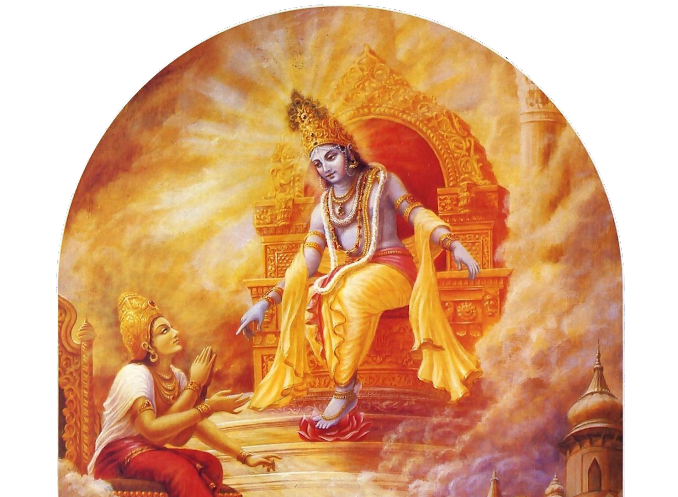
Vivaswan (Surya) the sun-god
On this planet the living beings have bodies made predominantly of earth and water which are suitable for living in this environment. But throughout the universe, living beings can have bodies made of earth, water, fire, air ether, mind, intelligence and false ego, or various combinations. The sun planet, for instance, is the abode of Vivaswan the sun-god and other demigods, who have fiery bodies. Why not? On some planets, the living entities may have bodies made of air, ether, mind, intelligence etc. which may be imperceptible to our senses, just as dogs can hear things we cannot, and snakes can see heat and make a thermal image of their prey. Arctic reindeers can see ultra-violet light to avoid predators and spot edible lichens. Birds such as finches can see extra colours we cannot see. Some people are able to see auras made of ether or ghosts which have only a subtle [mental] body.
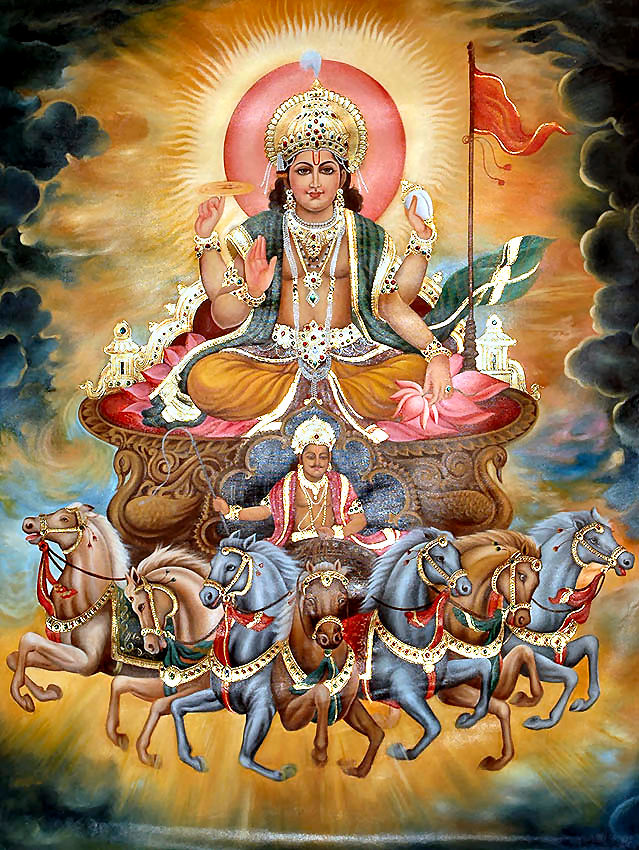
Because most scientists think that life is made of the chemical components of our bodies, they speak of conditions which can sustain life as being limited to the types of bodies found on this planet alone, which require a certain range of temperatures, humidity, pH etc. to keep body and soul together. Also, as some planets may be composed of much more subtle elements than our own, it is possible that there can be overlapping existences. For instance, when we dream, we [the soul covered by the astral or subtle body] leave our gross physical bodies and travel in the astral or mind dimension, experiencing dreams and nightmares.
On the cover flap of the First canto of Srimad Bhagavatam it is further stated:
The sun is situated almost in the centre of each and every universe, and it distributes profuse light and heat all over the universe. There are millions and billions of suns in all the millions and billions of universes within the mahat-tattva. The suns and moons are required within the universes because they are dark by nature. The Vedas instruct us to go out of the dark universes and reach the glowing effulgence of the brahmajyoti. The brahmajyoti is due to the illuminating Vaikuntha planets, which need no sun or moon or power of electricity. Srimad Bhagavatam helps us reach the supreme planet, Goloka Vrindavan. The door is open for everyone. Human life is meant for this particular aim, for it is the highest perfection.
The dwelling place of Krishna, our real home, is described in the following verse:
The Dwelling Place of Krishna
Above the highest heaven is the dwelling place of Krishna. It is a place of infinite idyllic peace, where the dark and gentle River Yamuna flows beside a flowered meadow, where cattle graze; on the river’s bank sweet-scented trees blossom and bend their branches to the earth, where peacocks dance and nightingales call softly. Here, Krishna, ever-young, sits beneath the trees, the sound of his flute echoing the nightingales’ call.
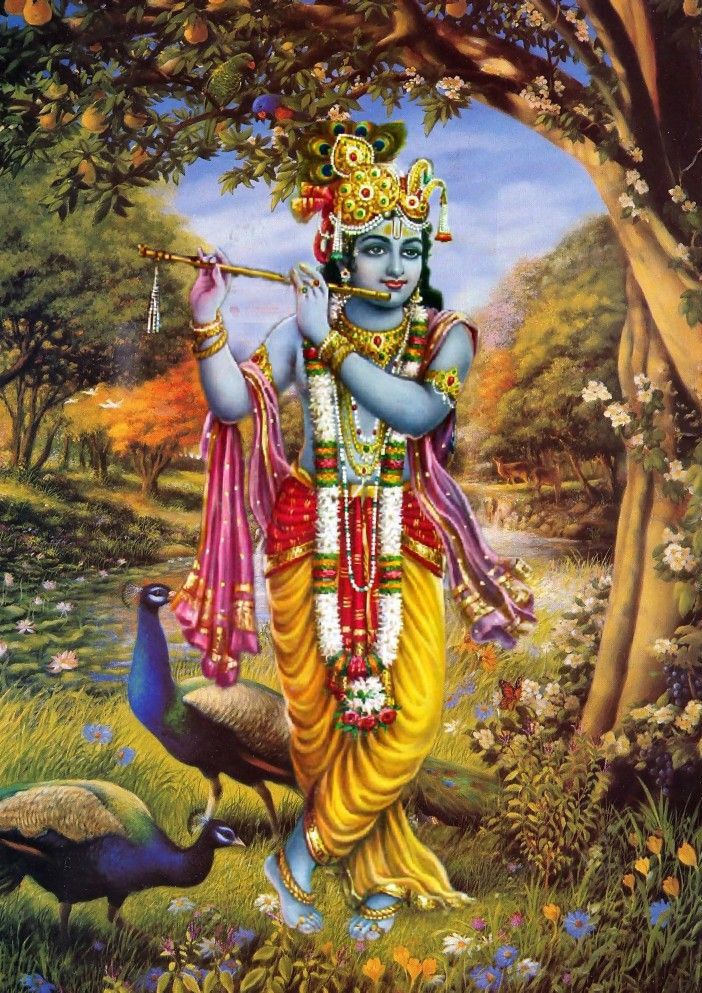

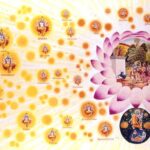
Leave A Reply